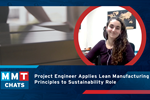Perspectives on Sustainability in Mold Building: A Diverse Outlook
In conversations with individuals involved in the mold building industry, a variety of perspectives on sustainability emerged, showcasing the multifaceted nature of the term.

In conversations I recently had with individuals involved in the mold building industry, a variety of perspectives on sustainability emerged, showcasing the multifaceted nature of the term.
Here’s a summary of the respondents’ viewpoints:
Tool longevity: One respondent emphasized the importance of building molds with robust, sustainable designs that endure the life of a program — the durability of tools, the maintenance of shut-offs and thin steel conditions.
Within the context of selling, engineering and manufacturing injection molds, sustainability centered around business processes and resources, questioning their scalability and profitability.
Recycled resins: The impact of post-consumer recycled (PCR) content on molds, molding processes and component compliance was highlighted, particularly through the use of recycled resin and thin-walled bottle designs. The challenges of incorporating PCR content into existing molds were also acknowledged.
Environmental responsibility: Some of my conversations touched on bringing environmental considerations to the forefront through a “green initiative” that involves dedicated employees focusing on green practices, including proper recycling, on the shop floor and in the office.
On one hand, it referred to environmental concerns, with a focus on preventing changes that make the Earth less habitable.Other environmentally friendly practices mentioned include using solar energy and recycling steel and brass scrap, safe handling of chemicals, and designing molds and parts to reduce material use.
Customer-specific challenges: In cases where projects are negotiated at a lower price than initially quoted due to budget constraints, questions about the sustainability of customer/vendor relationships arise. The sustainability of business ties can be compromised when customer budgets consistently fall short of quoted build prices.
Workforce and automation: The importance of retaining a skilled workforce, akin to sustaining fossil fuels, and incorporating automation as a form of renewable resources, continue to come to the forefront. Workforce, whether human or automated, was identified as the cornerstone of sustainable mold building. Educational initiatives to introduce trades to the new generation, making the industry more sustainable has been noted as well.
Broader challenges and opportunities ranged from rising energy costs and disrupted supply chains to reshoring, corporate governance and the role of moldmakers in driving sustainability within the industry. There is also the importance of defining sustainability, using resources intelligently and exploring innovative technologies for better sustainability outcomes.
What does sustainability mean to you?
To learn how one mold building operation takes on sustainability, click here. You’ll read about Velosity, a new brand launched in 2023 that represents Teamvantage, MMD Medical, Custom Mold & Design, CMD Precision and Paradigme Engineering — offering a full range of services, including mold building, injection molding, precision machining and custom contract manufacturing.
Related Content
-
Your Central Hub for Moldmaking Solutions
A print and online directory arming the mold manufacturing supply chain with the information mold buyers and mold builders need to make better purchasing decisions.
-
More Than Moldmaking at PTXPO 2023
The Moldmaking Pavilion returns to the Plastics Technology Expo (PTXPO) March 28-30, 2023, at the Donald E. Stephens Convention Center in Rosemont, Illinois, but there’s more to discover than moldmaking.
-
5 Moldmaking Metalworking Trends
Five trends helping to reshape the industry’s future by changing how mold builders work while opening the door to new opportunities.















